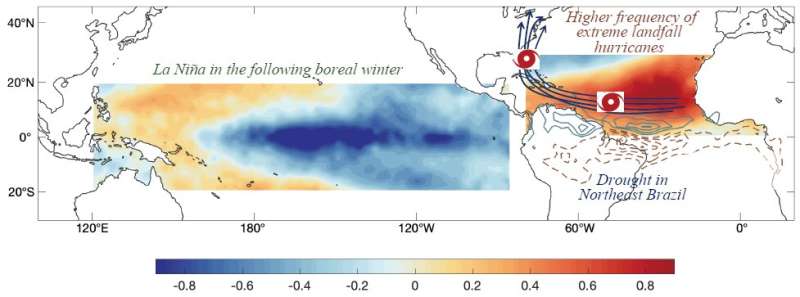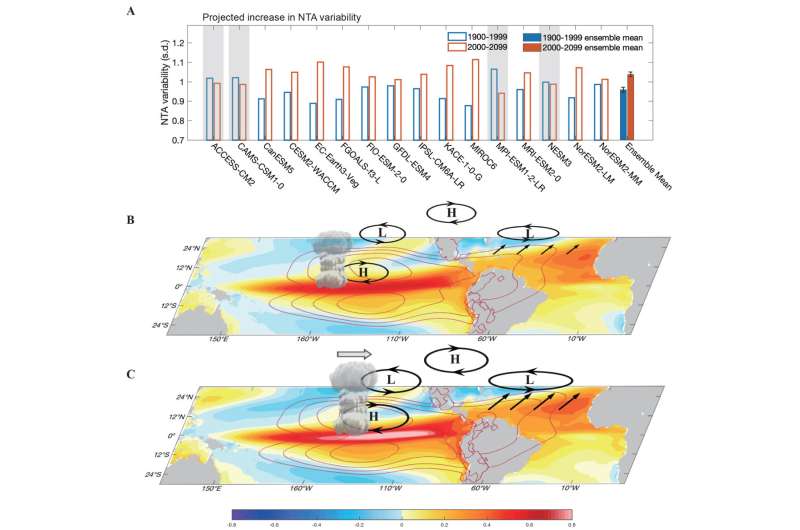Observed NTA warming events and their impact. Credit: IAP
North Tropical Atlantic (NTA) sea surface temperature anomalies are among the dominant and most consequential climate variations on Earth.
NTA warming events increase occurrences of extreme hurricanes and their landfall frequency along the U.S. East coast, induce severe droughts in Northeast Brazil, boost phytoplankton blooms in the Guinea Dome, and trigger La Niña events the following winter. Up until now, future changes in NTA variability and its underlying mechanisms have remained unknown.
A new study, however, has recently revealed that NTA variability is projected to increase in a warming climate. The research was conducted by an international team of 12 scientists from nine institutes around the world and results were published in Science Advances on August 25.
"The increase in NTA variability means not only strengthening of sea surface temperature anomalies but also increasing occurrences of extreme NTA events," said YANG Yun, associate professor at the College of Global Change and Earth System Science of Beijing Normal University and lead author of the study.
The increase in NTA variability and occurrences of extreme events mainly arises from an intensification of El Niño-Southern Oscillation (ENSO) influence, including ENSO-forced Pacific-North American pattern and tropospheric temperature anomalies.
Projected increase in North Tropical Atlantic (NTA) variability and underlying mechanisms. (A) Comparison of the NTA standard deviation (SD) over the present (1900 to 1999, blue-edged bars) and future (2000 to 2099, red-edged bars) periods in the 16 climate models. The multi-model ensemble means over the present and future periods are shown in blue-filled and red-filled bars, respectively; models that simulate a reduction are greyed out. (B) Climatic teleconnections induced by El Niño-Southern Oscillation (ENSO) in the present-day, as shown by sea surface temperature (color shading), wind (vectors), tropospheric temperature (red contour), convection (cloud) anomalies, and the associated Pacific-North American (PNA, high/low-pressure anomalies). (C) Same as (B) but for the future. H, high; L, low. NTA variability is projected to increase under greenhouse warming, due to an intensification of ENSO teleconnection. Specifically, ENSO-forced PNA pattern and tropospheric temperature anomalies strengthen in response to an eastward shift of ENSO-induced equatorial Pacific convection and a projected increase in ENSO variability. Credit: Yang et al., Sci. Adv. 2021; 7: eabg9690
ENSO-forced Pacific-North American pattern is enhanced in a warming climate because of the eastward shift of ENSO-related equatorial Pacific convection. This enhancement is further amplified by an increase in ENSO variability.
Co-author HUANG Gang from the Institute of Atmospheric Physics (IAP) of the Chinese Academy of Sciences further explained that "the strengthening of ENSO-induced temperature anomalies is due to combined effects of an increase in ENSO variability and amplified vapor response to ENSO."
"The consequence of an increase in ENSO variability and its teleconnections under greenhouse warming is more severe than previously thought, as the increase can energize dominant modes of climate variability remote from the Pacific, such as the NTA," said co-author CAI Wenju from the Centre for Southern Hemisphere Oceans Research, CSIRO Oceans and Atmosphere, Australia.
Given the profound climatic impact of NTA in inducing droughts, floods, and extreme hurricanes, this study adds to the urgency of reducing emissions of greenhouse gases.
More information: Greenhouse warming intensifies north tropical Atlantic climate variability, Science Advances (2021). advances.sciencemag.org/lookup … .1126/sciadv.abg9690
Journal information: Science Advances
Provided by Chinese Academy of Sciences

























